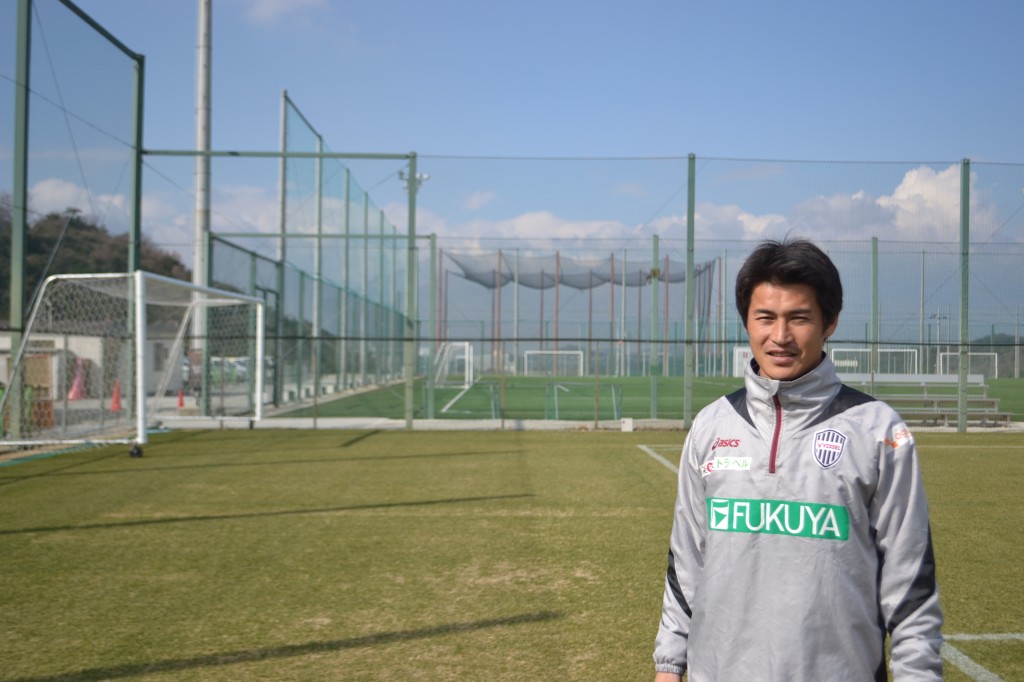 Photo: At the practice ground in Nishi Ward, Kobe
Charity match on the 20th anniversary of the Earthquake
Photo: At the practice ground in Nishi Ward, Kobe
Charity match on the 20th anniversary of the Earthquake
On January 17, 2015, the 20th anniversary of the Great Hanshin-Awaji Earthquake, a charity soccer match was held in Noevir Stadium Kobe which attracted over 24,000 spectators. The game was played between KOBE DREAMS (mainly consisting of former and present players of the Kobe-based professional soccer club, Vissel Kobe) and JAPAN STARS (mainly consisting of former national team members, including Hidetoshi Nakata and Hiroshi Nanami). Their heated, exciting 90-minute match captivated the watching fans.
On the KOBE DREAMS side, Takayuki Yoshida, who played as a forward for Vissel Kobe until 2013, assisted the second goal of Kazuyoshi Miura. Mr. Yoshida worked towards realizing this charity match for over a year, since he retired as a player and began working as the club’s Ambassador.
I thought that sharing the message “We haven’t forgotten” as a Kobe-based soccer club had a great significance on the 20th anniversary of the earthquake. That’s why I planned this charity match. I directly called each of possible participants to explain my idea. I was glad that all of them whose schedule permitted said that they wanted to participate.
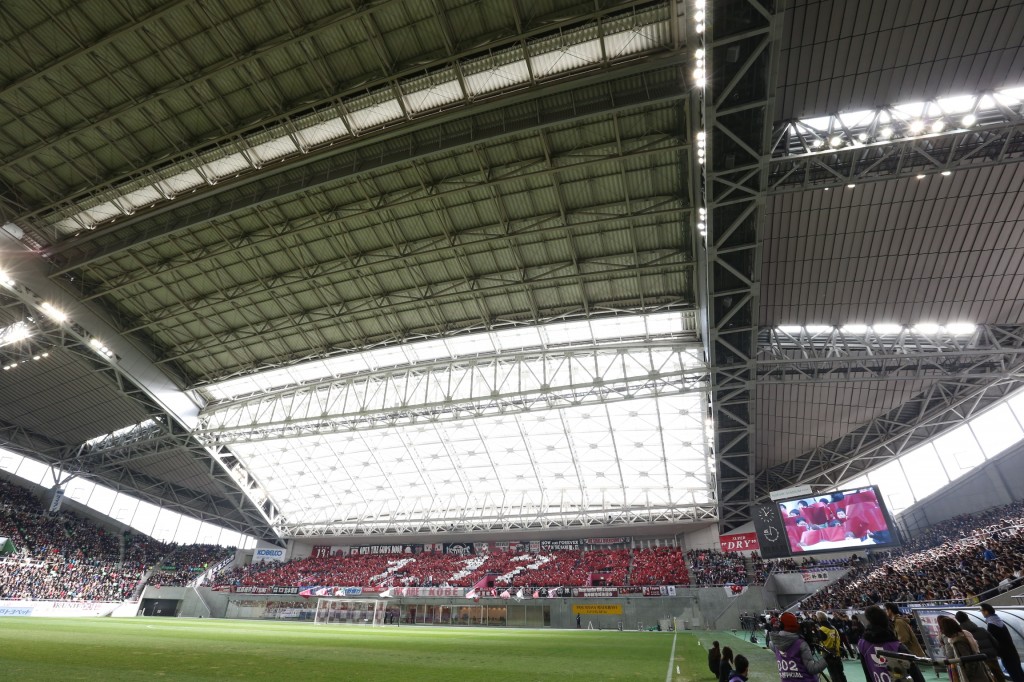 Photo: “1.17” formed by the spectators of the charity match ©The Great Hanshin-Awaji Earthquake 20th Anniversary 1.17 Charity Match Executive Committee
Photo: “1.17” formed by the spectators of the charity match ©The Great Hanshin-Awaji Earthquake 20th Anniversary 1.17 Charity Match Executive Committee
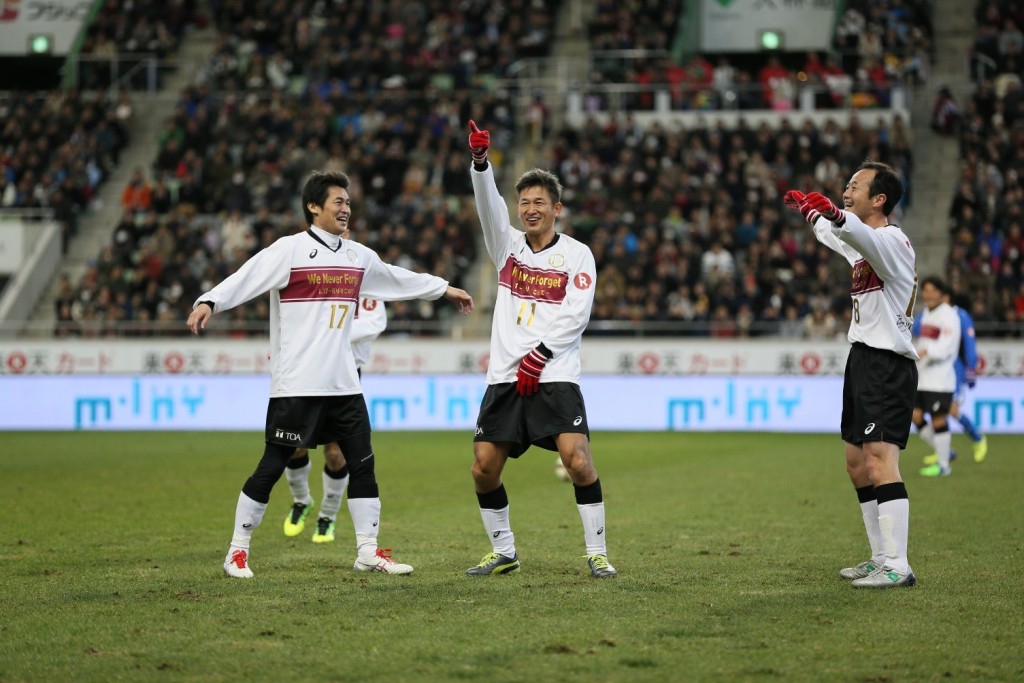 Photo: Mr. Yoshida (left) right after assisting Kazu’s goal ©The Great Hanshin-Awaji Earthquake 20th Anniversary 1.17 Charity Match Executive Committee
Photo: Mr. Yoshida (left) right after assisting Kazu’s goal ©The Great Hanshin-Awaji Earthquake 20th Anniversary 1.17 Charity Match Executive Committee
When the Great Hanshin-Awaji Earthquake struck, Mr Yoshida was in the third grade of Takigawa Daini High School, which is known for its soccer team.
I was temporarily back in my home in Kawanishi City on that day. Luckily, both myself and people around me suffered little damage. I was concerned about my friends who were staying in the dormitory of the soccer club. But I had no way to contact them, as electricity and transportation services were not available, and mobile phones were not prevalent in those days.
Since it had been decided that he would join the J. League club Yokohama Flügels (as the team was called at that time), he left the Kansai region in February with worries about Kobe in mind. In Yokohama, the club led support activities such as fundraising and charity events. He felt that the whole of Japan was cheering up Kobe.
The earthquake struck on Vissel Kobe’s first day
January 17, 1995 was the day when Vissel Kobe was to start its life as a professional soccer club. The earthquake occurred on the very first practice day, and their sponsors also suffered damage. The club that was born as a result of a signature-collecting campaign involving 240,000 Kobe citizens suddenly had to face a fateful crisis. Even after they started practicing in Kobe, they had to move from field to field in the affected areas.
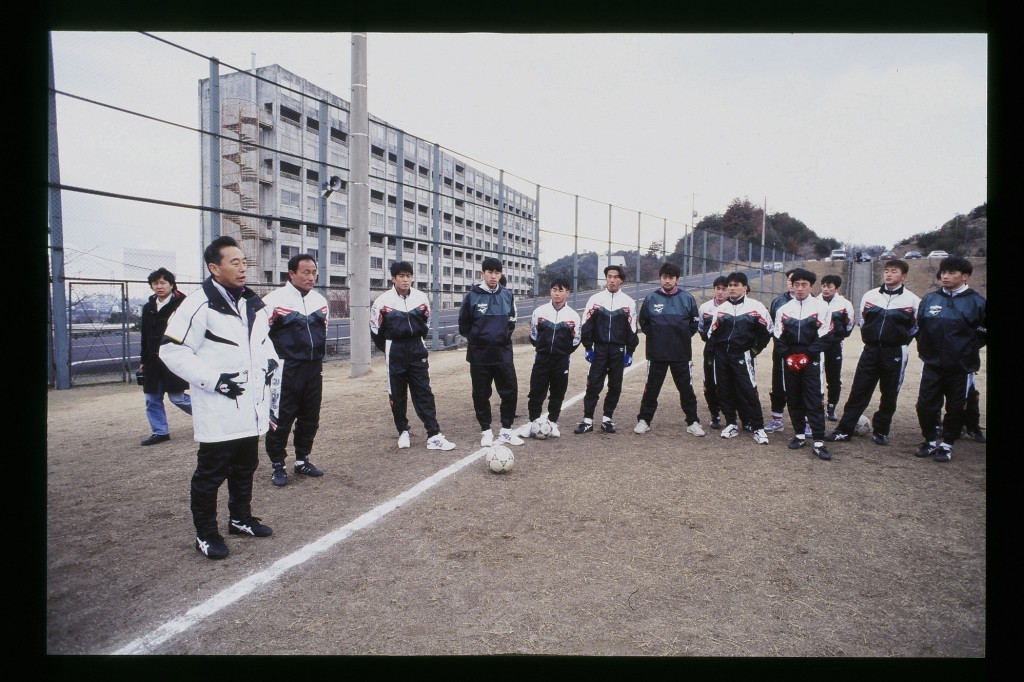 Photo: The team practicing just after the earthquake in 1995. There was temporary housing close to the pitch. ©VISSEL KOBE
Photo: The team practicing just after the earthquake in 1995. There was temporary housing close to the pitch. ©VISSEL KOBE
Akihiro Nagashima, whose parents’ house was damaged by the earthquake, once played for Vissel Kobe. Driven by his own desire to encourage Kobe, Nagashima transferred from Shimizu S-Pulse to Vissel Kobe in 1995. With strong solidarity, the club achieved promotion to the J. League in the following year, which greatly vitalized the city of Kobe. Vissel Kobe has taken steps during the course of 20 years together with Kobe and its citizens.
I was in Yokohama, so I heard about the situation after the earthquake from my senior teammates. They often kicked the ball into the temporary housing next to the practice field by mistake, but the residents encouraged the players, saying “Hang in there!” instead of yelling at them. Inspired by such experiences, the club finally realized its long-cherished wish: promotion to the J. League. In 2008 when I transferred to Vissel Kobe, the club again started the year’s activities on January 17. All players participated in a moment of silence.
Vissel Kobe surely has memories of the earthquake embedded in its roots. The program of the charity match traced the history of Japan, Kobe, and Vissel Kobe. It was made this way so that people who experienced the disaster could look back over their own experiences over the past 20 years, and those who hadn’t could learn about the situation of that time.
Ties through the two songs: “Bring Happiness to the World” and “Kobe Sanka (Hymn to Kobe)”
Two songs were sung before and after the match: “Bring Happiness to the World” and “Kobe Sanka (Hymn to Kobe)”. “Bring Happiness to the World” was written two weeks after the earthquake and has been sung mainly in elementary schools in Kobe as the symbol of reconstruction. On the day of the charity match, 106 students from Nishinada Elementary School sang the song on the side of the pitch.
* Link to “Bring Happiness to the World”:https://bekobe.smartkobe-portal.com/interview/2015/03/2760/ (in Japanese.)
“Kobe Sanka” was produced by Vissel Kobe’s supporters after the earthquake by changing the lyrics of “Hymne à l'amour.” This song has been sung at Vissel Kobe’s home matches since 2005.
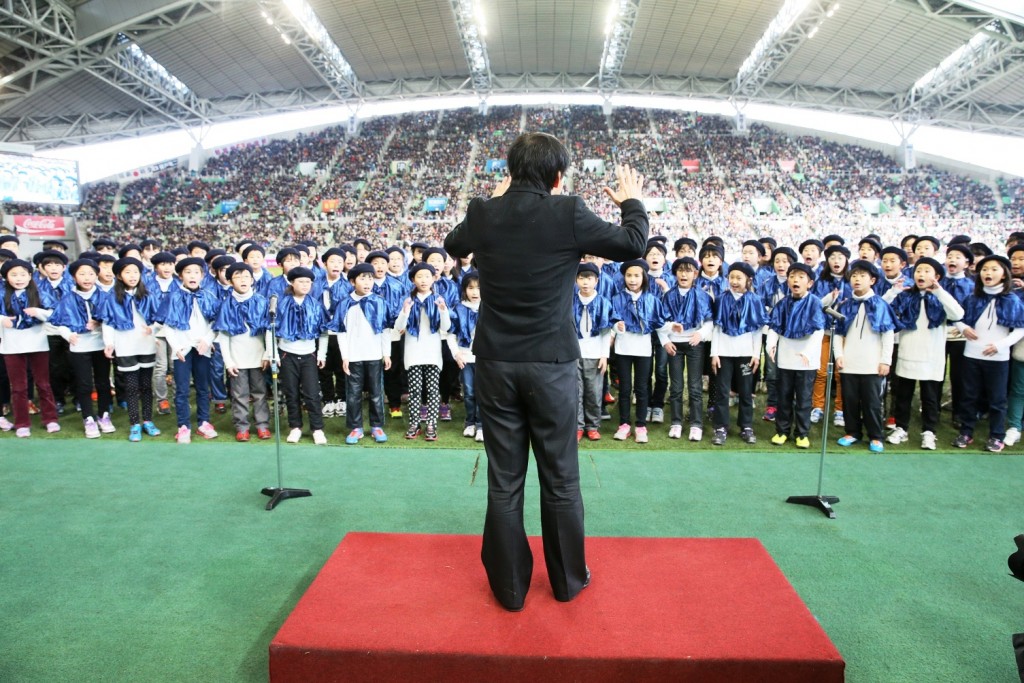 Photo: “Bring Happiness to the World” being sung by children and spectators before the match ©The Great Hanshin-Awaji Earthquake 20th Anniversary 1.17 Charity Match Executive Committee
Photo: “Bring Happiness to the World” being sung by children and spectators before the match ©The Great Hanshin-Awaji Earthquake 20th Anniversary 1.17 Charity Match Executive Committee
Every child in Kobe can sing “Bring Happiness to the World.” I wanted to share this song at the stadium in order to express our determination to never forget the earthquake. “Kobe Sanka” is a song that has connected people’s love for Kobe. There was a suggestion from supporters about singing this song, and the players in both teams readily agreed. So we were able to sing this song together, with arms on each other's shoulders. I hope that these songs will survive for decades, and for centuries.
“Kobe Sanka” (Translation of the lyrics)
On that day you were born
In the town we lived
We will never forget that day
Whatever may happen
Let’s share hardships
Let’s stand up together
Let’s keep going together
In the long years to come
We want to protect
This beautiful port town
We want to love Kobe
As long as we live
“Kobe Sanka” is now the identity shared by the club, supporters and the tcity. “To keep singing this song is to keep conveying the memory of the earthquake.” Many Vissel supports say that this is their mission. Love for the city that was fostered through sport contributed to community building and strengthened ties between people.
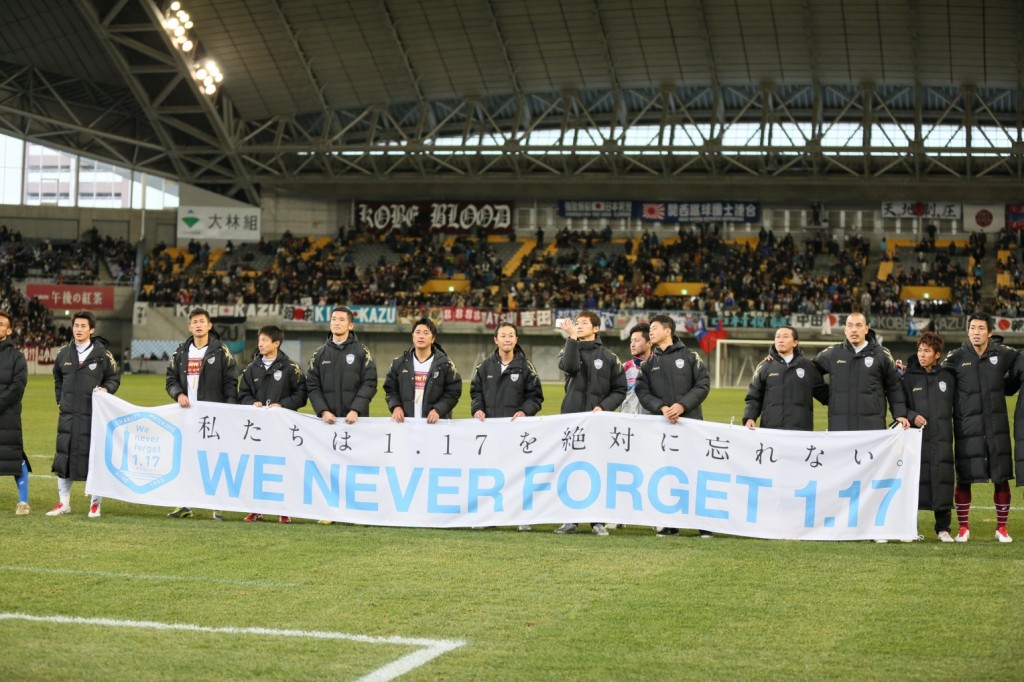 Photo: KOBE DREAMS singing “Kobe Sanka” with the fans at the stadium ©The Great Hanshin-Awaji Earthquake 20th Anniversary 1.17 Charity Match Executive Committee
The charity match was made possible by cooperation from companies in Kobe
Photo: KOBE DREAMS singing “Kobe Sanka” with the fans at the stadium ©The Great Hanshin-Awaji Earthquake 20th Anniversary 1.17 Charity Match Executive Committee
The charity match was made possible by cooperation from companies in Kobe
Mr. Yoshida also had a special feeling for companies and organizations that offered cooperation to the charity match.
I am truly pleased to see that the Kobe Shimbun and other companies and organizations that suffered great damage have successfully achieved restoration, and recovered enough energy to support an event like this.
We put our all into the match to bring satisfaction to the over 24,000 fans who bought tickets. We also organized various events to have everyone feel gratitude for being able to play soccer and enjoy watching the game, and to enhance this feeling into awareness of disaster risk reduction.
Video footage was broadcast before the match, introducing a disaster drill by the players. The ShakeOut Drill was also held in the main stand with participation of all the fans.
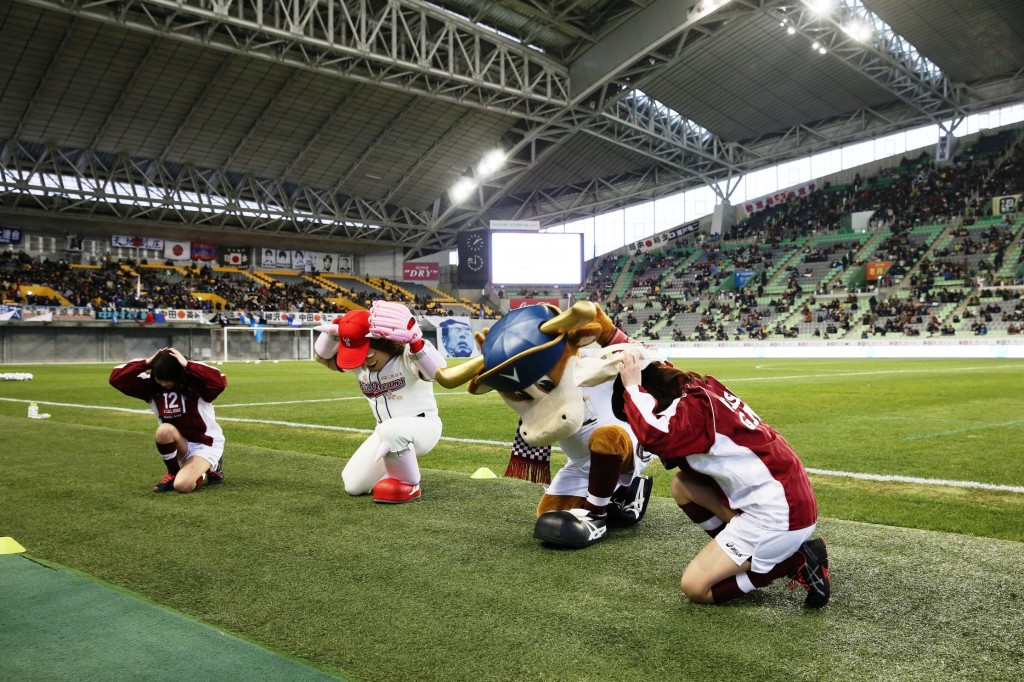
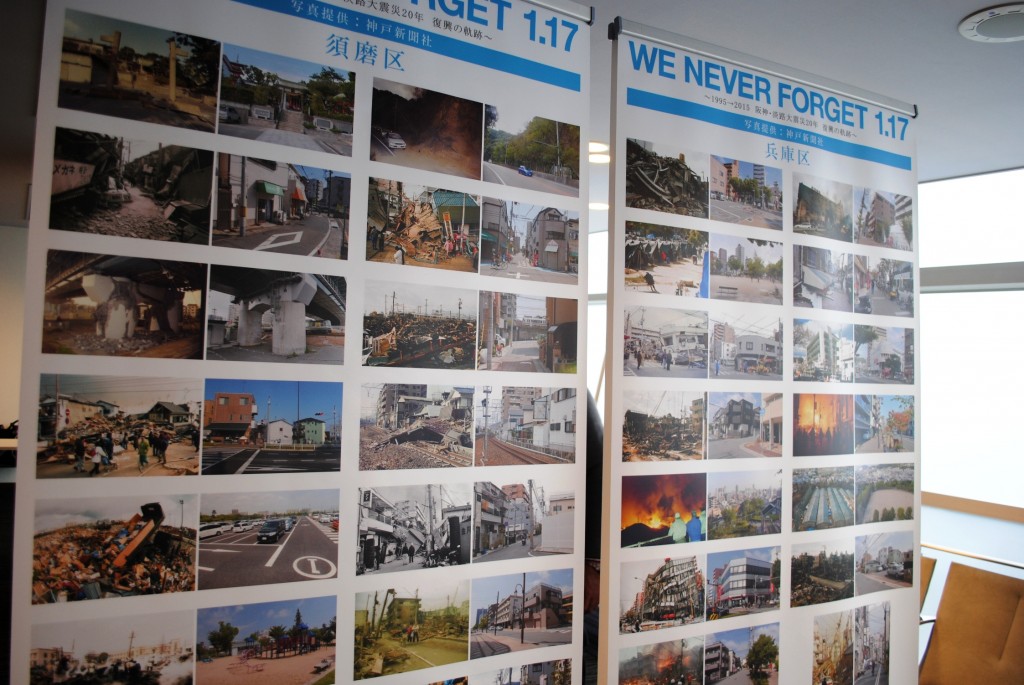 Photo: ©The Great Hanshin-Awaji Earthquake 20th Anniversary 1.17 Charity Match Executive Committee
Photo: ©The Great Hanshin-Awaji Earthquake 20th Anniversary 1.17 Charity Match Executive Committee
Many events to raise awareness took place outside the stadium as well, such as a photo exhibition by the Kobe Shimbun, and a PR activity by “117 Kobe Bosai Committee” made up of 40 students from six universities in Kobe.
We never forget 1.17 ~ with fervent prayers ~
When the Great East Japan Earthquake struck on March 11, 2011, Vissel Kobe was among the first J. League clubs that took prompt action. This evoked the launch of various support activities. Now, over 20 years after the establishment of the professional soccer league in Japan, ties among supporters and clubs have spread nationwide and the spirit of mutual help has been fostered beyond rivalry.
Supporters and clubs launched many support activities after the Great East Japan Earthquake and the 2014 landslides in Hiroshima. Mutual help in the soccer community is also found overseas, but a movement covering the whole country is unique to Japan, which is one of the sport cultures that Japan can take pride in.
Finally, Mr. Yoshida made this comment, comparing himself just after the earthquake and at present.
When I was young, I was thinking only of myself playing soccer. As I grew older, I learned to take the entire team into consideration. Maybe there are people who have no idea about how to face the incidents of Kobe and Tohoku right now. But I believe that the time will come when they will find their own way of commitment to society as time goes by.
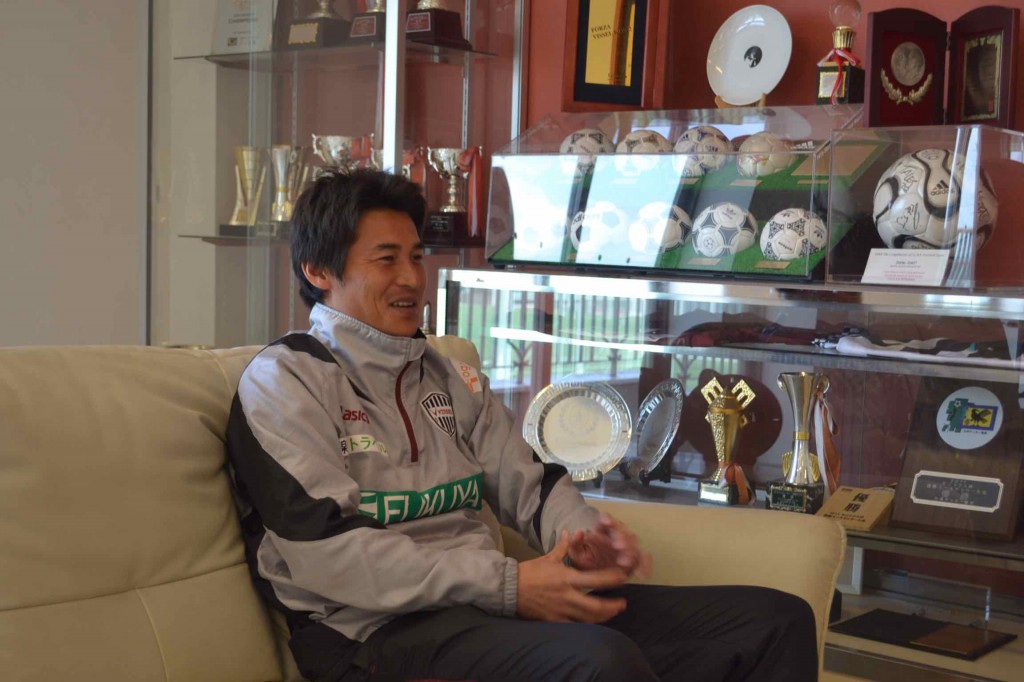
The charity match might have been the very opportunity for Yoshida to find that way clearly.
The club has become stronger because of the earthquake. As long as the club is in Kobe, the experience and memories of the earthquake will be passed down to the future. The message of the charity match “We never forget 1.17 ~ with fervent prayers ~” will continue to survive in years to come.
With the soccer club born in Kobe, with the city of Kobe,
And with each of us.
(Interviewed and written by Yoshihito Higashi)
This article was created with the cooperation of
greenz.jp.
![]() a soccer coach
a soccer coach JP | EN
JP | EN JP | EN
JP | EN Photo: At the practice ground in Nishi Ward, Kobe
Photo: At the practice ground in Nishi Ward, Kobe Photo: “1.17” formed by the spectators of the charity match ©The Great Hanshin-Awaji Earthquake 20th Anniversary 1.17 Charity Match Executive Committee
Photo: “1.17” formed by the spectators of the charity match ©The Great Hanshin-Awaji Earthquake 20th Anniversary 1.17 Charity Match Executive Committee Photo: Mr. Yoshida (left) right after assisting Kazu’s goal ©The Great Hanshin-Awaji Earthquake 20th Anniversary 1.17 Charity Match Executive Committee
Photo: Mr. Yoshida (left) right after assisting Kazu’s goal ©The Great Hanshin-Awaji Earthquake 20th Anniversary 1.17 Charity Match Executive Committee Photo: The team practicing just after the earthquake in 1995. There was temporary housing close to the pitch. ©VISSEL KOBE
Photo: The team practicing just after the earthquake in 1995. There was temporary housing close to the pitch. ©VISSEL KOBE Photo: “Bring Happiness to the World” being sung by children and spectators before the match ©The Great Hanshin-Awaji Earthquake 20th Anniversary 1.17 Charity Match Executive Committee
Photo: “Bring Happiness to the World” being sung by children and spectators before the match ©The Great Hanshin-Awaji Earthquake 20th Anniversary 1.17 Charity Match Executive Committee Photo: KOBE DREAMS singing “Kobe Sanka” with the fans at the stadium ©The Great Hanshin-Awaji Earthquake 20th Anniversary 1.17 Charity Match Executive Committee
Photo: KOBE DREAMS singing “Kobe Sanka” with the fans at the stadium ©The Great Hanshin-Awaji Earthquake 20th Anniversary 1.17 Charity Match Executive Committee
 Photo: ©The Great Hanshin-Awaji Earthquake 20th Anniversary 1.17 Charity Match Executive Committee
Photo: ©The Great Hanshin-Awaji Earthquake 20th Anniversary 1.17 Charity Match Executive Committee